Sprinkler data sheets are a rich source of product and technical information—if you can read them efficiently
Dear reader, we’ll tell you a secret: the QRFS team knows a lot about fire protection but not everything, and certainly not by heart. We research various topics, so you don’t have to. And among our best sources are fire sprinkler data sheets. The trouble is that these info gold mines can be difficult to read for someone unfamiliar with them. This blog aims to make it easier, starting with Viking fire sprinkler data sheets.
Viking’s latest documents are usually generally broken up into the following sections:
- Sprinkler identification numbers (SINs) and core features
- An ordering guide
- Approval tables and listings
- Design and installation guidelines
This article is about how to locate detailed information. But if you simply want to find the right sprinkler, escutcheon, cover plate, or wrench fast, try our Quick Finder tool!
Sprinkler identification numbers (SINs) and core sprinkler features
One of the first things you’ll see in a sprinkler data sheet is the SIN, or sprinkler identification number. All approved fire sprinklers made after 2000 have one of these alphanumeric codes. The SIN starts with one or two letters revealing the manufacturer and ends with three to five numbers indicating the model. All of Viking’s SINs start with “VK.”
Every distinct sprinkler model has a unique SIN, and “distinct” is based on a mix of these features:
- Response element (fast response or standard response)
- Coverage area (standard coverage or extended coverage)
- K-factor (which refers to orifice size governing how much water comes out and how quickly)
- Orientation (upright, pendent, concealed pendent, sidewall, or concealed sidewall)
- Sprinkler type (standard spray, residential, storage, MRI-safe, etc.)
If just one of these elements changes, it’s a new SIN. For more information about this topic, check out our previous blog.
Viking data sheets give you most of this information right up front. In the top right corner, you’ll see a box that lists the defining features of the sprinkler, plus its SIN. But sometimes, one data sheet will explain multiple sprinklers/SINs.

Ordering guide for sprinklers and other parts
The SIN defines the sprinkler’s core features. So, that’s all you need to know, right? Nope.
A given SIN can have dozens of variations because of the different temperature ratings and finish options, not to mention whether the threads are in inches (used mainly in North America) or millimeters (much of the rest of the world).
Things get more complicated when you add cover plates for concealed sprinklers—these can have different shapes, temperature ratings, colors, and special features—and matching listed escutcheon options for recessed or flush sprinklers. And then, there are compatible wrenches, head guards, and other tools.
To help you order the correct parts, Viking provides ordering guides in its data sheets. Non-concealed sprinklers typically have a single table that covers all the options. For concealed sprinklers, you get two tables: one for the sprinkler and one for the cover plates. Either way, these ordering guides help you start with the SIN and drill down to a specific Viking SKU or part number so you can order the exact item you need.
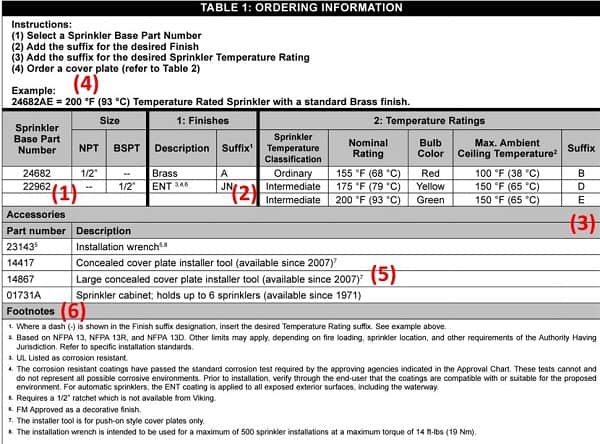
Viking uses part numbers for stockkeeping (marked “1” in the picture above). Here, two different part numbers correspond to the concealed pendent with the SIN VK4621. One is for heads in NPT threads/inches heads, while the other is for the BSPT thread/millimeter version.
To drill down into options, go to the next columns covering finishes (“2”) and temperature ratings (“3”). Each provides a “Suffix” that applies to the end of the part number. For example, an “A” indicates a brass-finished sprinkler, and “B” means an ordinary temperature classification at a 155°F activation temperature. Thus, the part number “24682AB” refers to a 1/2″ NPT-thread sprinkler with a 155°F activation temperature and a brass finish.
Viking even provides an example in the data sheet (“4”).
Ordering guides also list part numbers for helpful or vital accessories—like wrenches, installation tools, and sprinkler cabinets (“5”).
Finally, don’t forget to read the footnotes (“6”). Data sheets often use many superscripts and footnotes to communicate key information. It’s important to check this section because it tells you useful things—like whether the installation wrench requires a separate ratchet or whether a finish is specifically “listed” (tested and approved) as corrosion-resistant (and by whom).
More on listings next!
Listing and approval table
Unfortunately, some shady fire protection equipment exists that’s for sale online—even counterfeit fire sprinklers posing as the real deal. A buyer has no idea whether iffy sprinklers will activate in a fire, leak, or go off prematurely. One reason for doubtful performance can be they aren’t listed.
Sprinklers and many other fire protection parts must be listed (or otherwise approved) for use. A listing indicates that a recognized safety organization has tested sprinklers and other items for reliability, performance, and safety.
The two most prominent organizations in this space are UL and FM Global. But many data sheets also feature other listings from different worldwide organizations, such as:
- CE
- LPCB
- VdS
- UKCA
- MED
On the front page and in the tables of many Viking data sheets, you’ll find the listings for a sprinkler and its features and accessories.
But “listing” isn’t always just a yes or no thing—while all sprinklers must be listed for essential performance, different aspects can be listed and not others. For example, UL might list a specific finish as corrosion-resistant but not others, and FM might not approve a particular finish as corrosion-resistant, whereas UL does.
NFPA 13 requires listed sprinklers, covers, and escutcheons. In contrast, things like corrosion-resistant finishes may only need it in certain environments to achieve specific rules (like time intervals for testing or replacing corrosion-resistant sprinklers).
In addition, building authorities, fire marshals, and insurance companies (all “authorities having jurisdiction”) might sometimes prefer specific approval marks or multiple ones. For example, the fire marshal is usually just fine with FM or UL marks (either meets NFPA requirements that something must be listed), but an insurance company might insist upon one or both.
For example, the listing and approval table in a Viking data sheet has detailed information about listings and specs for things like:
- A sprinkler qualifying as standard or quick response
- Maximum working water pressure
- Sprinkler temperature rating
- Escutcheons tested as part of the sprinkler assembly
- Cover plates tested as part of the sprinkler assembly, and their temperature ratings
- Sprinkler finish
Interpreting the approval table can be a little tricky‚ at first. Let’s look at an approval table for the VK4621 concealed pendent. We break the table into two parts, top and bottom:
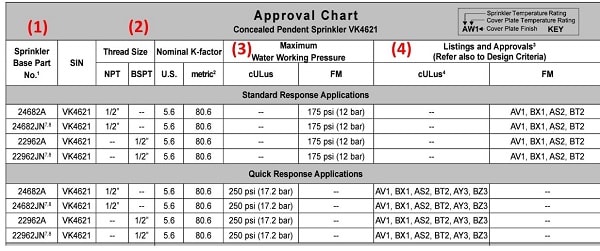
To read the upper half of the table, it helps to go column by column—again, the numbers below refer to the red numbers in the image above:
- Sprinkler Base Part Number (including the finish suffix). Superscripts in this column direct you to footnotes at the bottom of the table, where you’ll get information about whether finishes are UL-listed or FM-approved as corrosion-resistant. Approved custom paint finishes might also be available.
- The table includes SIN, Nominal K-factor, and Thread Size
- Max Water Working Pressure; above, UL lists these sprinklers as quick response with a max water pressure of 250 PSI. FM Global approves them as standard response with a max pressure of 175 PSI.
- Listings and approvals. This section uses codes (“AV1,” “BX1,” etc.) to reference different temperatures and sprinkler assemblies (sprinkler-cover plate combinations). The meaning of these codes is given in the second part of the table, shown below:

The columns of this lower part of the table contain the possible specs and features for this Viking concealed pendent sprinkler assembly:
- Sprinkler Temperature Ratings
- Cover Plate Assembly Temperature Ratings
- Cover Plate Assembly Finishes
So, a “BZ3” part-number suffix indicates a sprinkler rated at 175°F that has a 165°F clean room cover plate in a polished chrome finish.
After finding the suffix/feature combination you want, refer back to the first half of the table to see whether it’s available in that combo and what it’s listed for.
For example, “BZ3” is listed by UL as a quick response sprinkler. So, individuals looking to buy concealed sprinklers for their clean room in a hospital or similar light-hazard occupancy are good to go!
Design criteria
It might seem strange that manufacturers give us design criteria in a data sheet in addition to the definitive rules found in NFPA 13: Standard for the Installation of Sprinkler Systems and other standards (NFPA 13R and NFPA 13D). So, what gives?
Viking data sheets have design criteria sections for three reasons:
- To explain which parts of NFPA 13 you should reference
- To give you enough information to apply NFPA 13R or NFPA 13D
- To tell you what other rules to use (if you have to use them)
UL listings—helpful info for NFPA 13
Viking doesn’t provide an extensive design criteria section for most commercial sprinklers because you’ll rely on NFPA 13. Rather, the goal is to help designers apply NFPA 13 to the particular sprinkler in a data sheet.
This design criteria section for a UL listing is a great example of this concept, specifying that the VK4621 is appropriate for certain hazard occupancies, spacing rules, etc., found in NFPA 13:
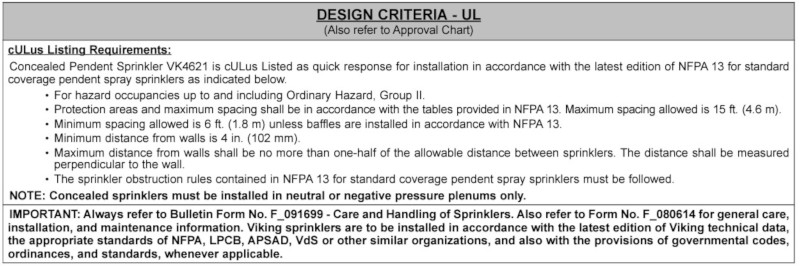
How to apply other standards
Viking may also provide design criteria when an approval organization wants you to use different rules than those found in NFPA 13. This information typically relates to FM Global, not UL. The data sheet refers the reader to the correct FM document with the warning: “The FM installation guidelines may differ from cULus and/or NFPA criteria.”
Design criteria for residential sprinklers in Viking fire sprinkler data sheets
Viking fire sprinkler data sheets for residential sprinklers have extremely detailed design criteria with spacing, coverage area, flow, and pressure rules. We’ve reproduced an example of this information from an approval chart below:
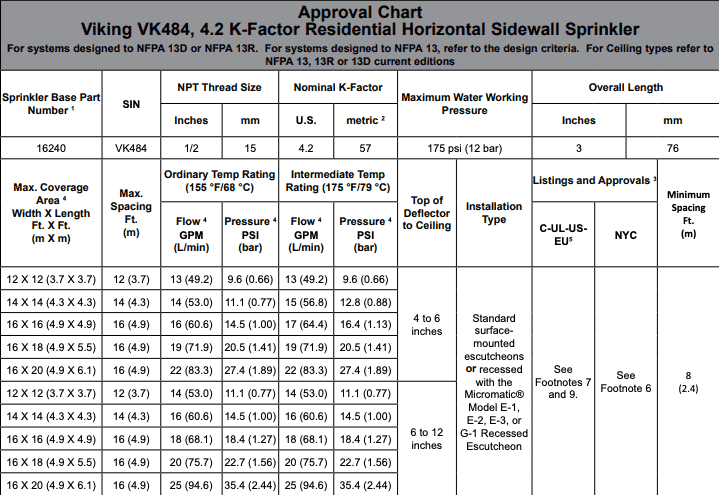
As the above table says, this information is for sprinkler system designers and engineers planning “systems designed to NFPA 13D or NFPA 13R.” NFPA 13R is the Standard for the Installation of Sprinkler Systems in Low-Rise Residential Occupancies, and NFPA 13D is the Standard for the Installation of Sprinkler Systems in One- and Two-Family Dwellings and Manufactured Homes.
Viking spells out the design criteria for residential sprinklers because both these NFPA documents expect designers to refer to the listings. The info in the data sheet effectively replaces the NFPA 13 criteria that govern commercial sprinklers.
As you can see from our example, these design rules are actually part of the “approval table” section. It’s because different authorities approve various specs (sprinkler spacing, pressure, etc.). But you’ll also find a lot of design information (especially for sprinkler layouts) in the installation guide section of residential data sheets.
Installation guidelines in Viking fire sprinkler data sheets
The last section of a Viking data sheet has installation guidelines.
For upright sprinklers, this section is pretty simple, with no or few pictures. There’s only one way to install an upright, after all.
But there are different ways to install pendent, sidewall, and concealed sprinklers and their escutcheons and cover plates. Data sheets for these sprinklers include multiple diagrams showing what is allowed and how (such as installation depth and any possible adjustments).
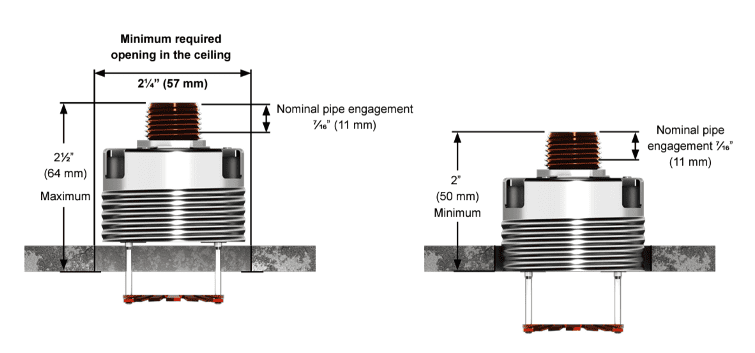
Alongside the diagrams, Viking provides step-by-step sprinkler installation and handling instructions.
Reading Viking fire sprinkler data sheets isn’t as hard as it might first seem
Sprinkler manufacturers like Viking pack a ton of info into their data sheets, and these documents may seem daunting—at first. But once you know how to navigate everything, you can quickly find details about:
- Sprinkler SINs in core features
- Ordering different versions of a sprinkler (and its accessories)
- Listings and approvals
- Design criteria
- Installation rules
This information is valuable for sprinkler engineers, installers, and facilities managers. Now, you know how to find it. But if you want to find a sprinkler or other compatible part much faster:
Use the QRFS Quick Finder!
Just enter the sprinkler identification number (SIN) for the related sprinkler, select a few options (finish, temperature, and adjustment range, if applicable), and it shows you the correct parts.
Still have questions? Contact us at 888-361-6662 or support@qrfs.com.
This blog was originally posted at blog.qrfs.com. If this article helped you, check us out at Facebook.com/QuickResponseFireSupply or on Twitter @QuickResponseFS.


